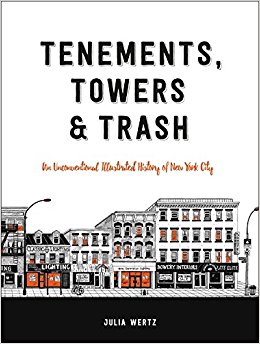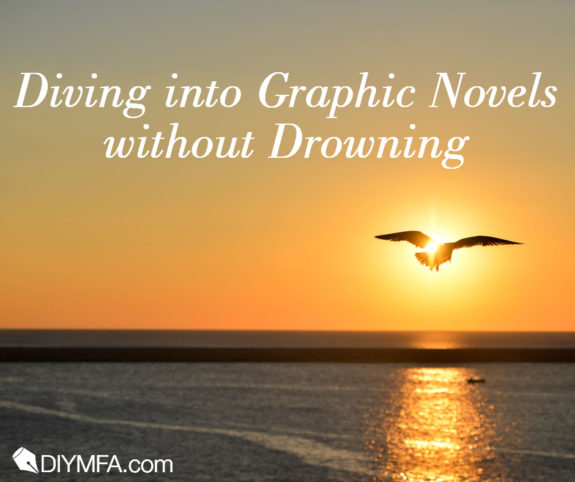Do you want to let drawing become a part of your writing life, but are afraid to start? Do you long to dive into the world of books with pictures, but fear drowning? Let this article be your floaties to keep you safe in the deep end of the graphic novel pool.
First, some history. Graphic novels began as compilations of comic books. Now they are more than that. The end.
While Marvel and DC comics compilations still dominate the shelf space in any graphic novel section of a bookstore, there is a growing presence of other work. The trick is finding what rocks your world, especially if you feel out of place browsing for books with pictures when you venture away from the children’s section or, yikes, dare to venture into a comics store.
One of the joys of seeking out inspiration on the graphic novel shelves is that you can browse books quickly. When you open a book, you’ll know right away if the drawings move you. If a book catches your eye, spend some time with it. Examine what resonates with you. Study the books you love and let them encourage you to make drawing a part of your own writing life.
To help you get started, what follows is a lexicon for books with pictures often shelved in the graphic novel section of a bookstore. The bulleted titles offer samples for the subgenres. Each book listed is single-authored to help dispel the myth that people can’t be both accomplished writers and artists. You can write and draw. Believe this.
 Graphic Novel
Graphic Novel
In the true sense of the term, these are works of fiction. However, in the graphic novel section, you can find true and imagined stories as well as hybrids of both. The traditional graphic novel follows the production-line process of Marvel and DC comics and are often created by multiple artists—the writer, story-boarder, penciller, inker, colorist, letterer and cover artist. They evolved from the industry standard of the comic book, so include pages of panels that convey a linear narrative, the story dominated by images and dialog. Superheroes abound. These books may take up the bulk of shelf space, but they are no longer the end-all for storytelling with pictures beyond the children’s book section.There are a growing number of graphic novels that escape the Marvel/DC empire, including these two:
-
- Nausicaä of the Valley of the Wind by Hayao Miyazaki, first published as a serial comic (1982-94), is an example of manga comics and chronicles the adventures of a female protagonist in a post-apocalyptic world mired in ecological disaster. Miyazaki is masterful in the pencil-drawings and storytelling for this two-volume graphic novel.
- Daytripper by Gabriel Bá and Fábio Moon, twin brothers from Brazil who together craft a stunning story of a man who encounters his own death multiple times throughout his life.
Two subgenres of books with pictures in the expanding shelf of graphic novels (that aren’t novels) are diary comics and graphic memoirs. The distinction between them is the same as in books without pictures. Diaries recollect the day in progress, while memoirs recall the arc of an experience after it has happened.
 Diary Comics
Diary Comics
If you like eavesdropping on funny, talented, often introverted people, check out a collection of diary comics. Often these books amass a year or more of online posts or serial print zines.
-
- Invincible Summer by Nicole J. Georges, originally published as zines, follows the daily trials of Georges as a young queer vegan punkster moving from Kansas to Oregon.
-
- Museum of Mistakes by Julia Wertz, the collected Fart Party diary comics of a hilarious cartoonist’s early years of day-to-day torment.
- You, the Bike & a Road by Eleanor Davis, the collected daily penciled pages drawn while solo-bicycling from Tucson, Arizona, to Athens, Georgia.
Graphic Memoir
Memoirs with images often get shelved as graphic novels, especially if they’re structured like comics. Some, like mine, are shelved in the memoir section.
-
- Fun Home by Alison Bechdel, a memoir of a father-daughter relationship by the MacArthur genius award-winning cartoonist.
-
- My Lesbian Experience with Loneliness by Nagata Kabi, an intimate example of Manga comics. Manga is a comics art form originating in Japan. Books and pages are read right to left.
- Rosalie Lightning by Tom Hart, a heart-rending story of surviving the loss of his daughter, Rosalie, who was not yet two when she died.
 Other Graphic Creative Nonfiction
Other Graphic Creative Nonfiction
In addition to comics diaries and graphic memoirs, these books span the same expanding gamut as text-only creative non-fiction, from biography to theory, and any true story in-between.
-
- Brief Histories of Everyday Objects by Andy Warner, a hilarious history of the toothbrush and more.
-
- Maus by Art Spiegelman, Pulitzer Prize-winning work of genius, with Jewish people depicted as mice, reveals the story of the Holocaust gleaned from interviews with his father.
-
- Radioactive: Marie & Pierre Curie: A Tale of Love and Fallout by Lauren Redniss, National Book Award finalist, reads like an illuminated painting.
-
- Tenements, Towers & Trash by Julia Wertz, a visual personal history of New York City architecture and public space.
-
- Understanding Comics by Scott McCloud, the seminal book on sequential art theory that is, of course, a work of sequential art.
- Unflattening by Nick Sousanis, the first doctoral dissertation done in graphic novel form, totally mind-bending.
Comics Poetry aka Poetry Comics
This is a work of a lyric nature that reads like poetry, with words and images.
-
- Ink Brick: a journal of comics poetry (mostly single-authored, but includes some collaborations)
- Poetry Comics from the Book of Hours by Bianca Stone, a pioneer in this genre who prefers to call it poetry comics, since, for her, poetry comes first.
 Hybrids
Hybrids
Here’s the thing—mingling words with images is a hybrid creation, so it’s natural that work by these artists/writers also blurs and bends genre categories.
-
- Becoming Unbecoming by Una, a deeply personal narrative that weaves in sexual abuse statistics. This book is both graphic memoir and manifesto for empowering women.
-
- Cartooning the Landscape by Chip Sullivan, a mix of history, fiction, and treatise on seeing and the mechanics of interpreting landscape in beautiful watercolor and ink.
-
- My Favorite Thing is Monsters by Emil Ferris, described by the publisher as a fictional graphic diary, the book chronicles the life of a young monster coming of age in 1960s Chicago, and is a 2018 Lambda Literary Award winner.
-
- The Magical Life of Long Tack Sam by Ann Marie Fleming, a comics-form biography collage of photographs, paper ephemera, drawings and words.
- Syllabus by Lynda Barry offers page after page of saturated wisdom about teaching, creativity and being human.
“Reading” books with pictures is an immersive experience. You can read the words while drifting past the imagery, letting the pictures carry you as you navigate the story told in words. You can also dive into the images, following what catches your eye, marveling in the craft and content. Much like you do when reading text-only work whose delicious words transcend the plot line. Or you can shift back and forth between words and images. Either way, you get to choose where your eye roams and how your mind absorbs the story.
Dive in!
 Rebecca Fish Ewan, a poet/cartoonist/writer and founder of Plankton Press, teaches in The Design School at Arizona State University. She grew up in Berkeley, California, and now lives in Arizona with her family. Her cartoon/free verse memoir, By the Forces of Gravity, was published in 2018 through Books by Hippocampus. You can connect with her at rebeccafishewan.com.
Rebecca Fish Ewan, a poet/cartoonist/writer and founder of Plankton Press, teaches in The Design School at Arizona State University. She grew up in Berkeley, California, and now lives in Arizona with her family. Her cartoon/free verse memoir, By the Forces of Gravity, was published in 2018 through Books by Hippocampus. You can connect with her at rebeccafishewan.com.







